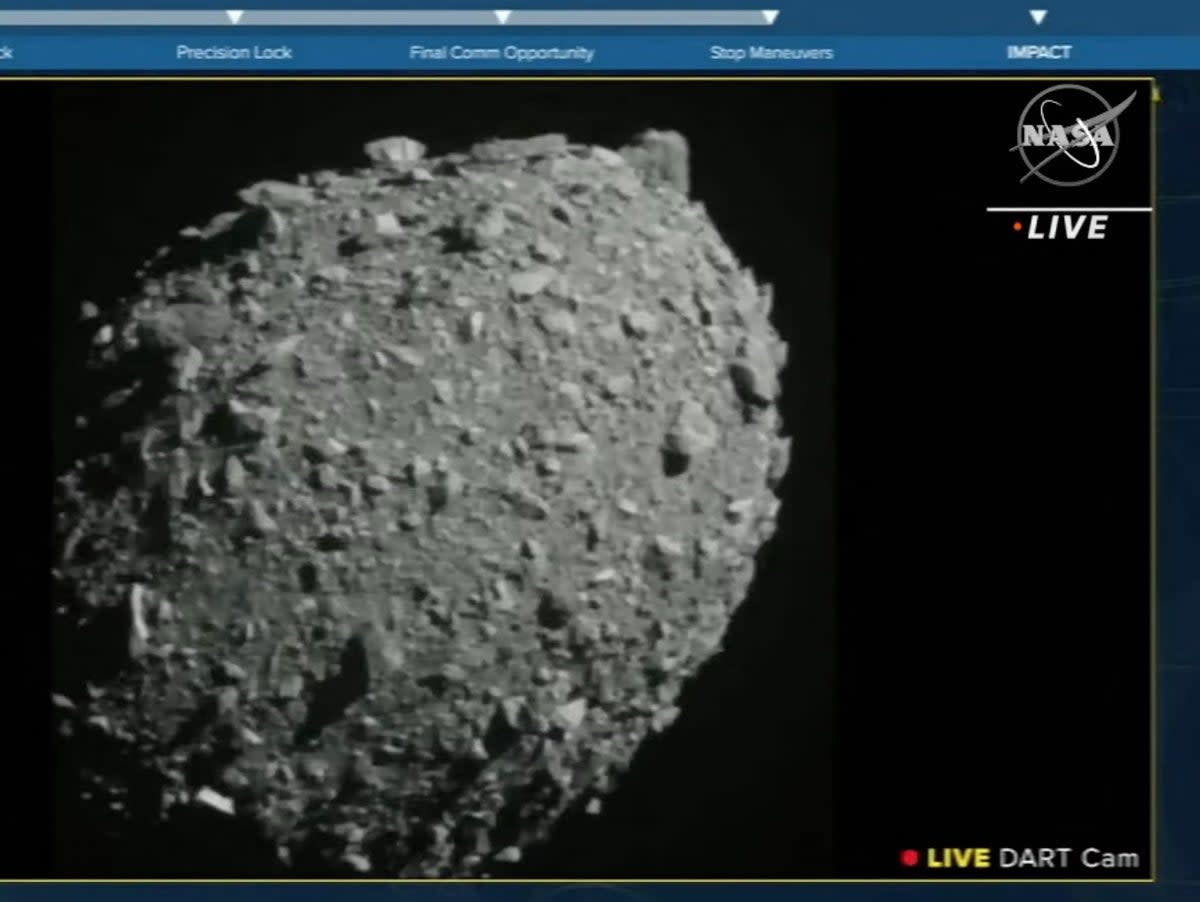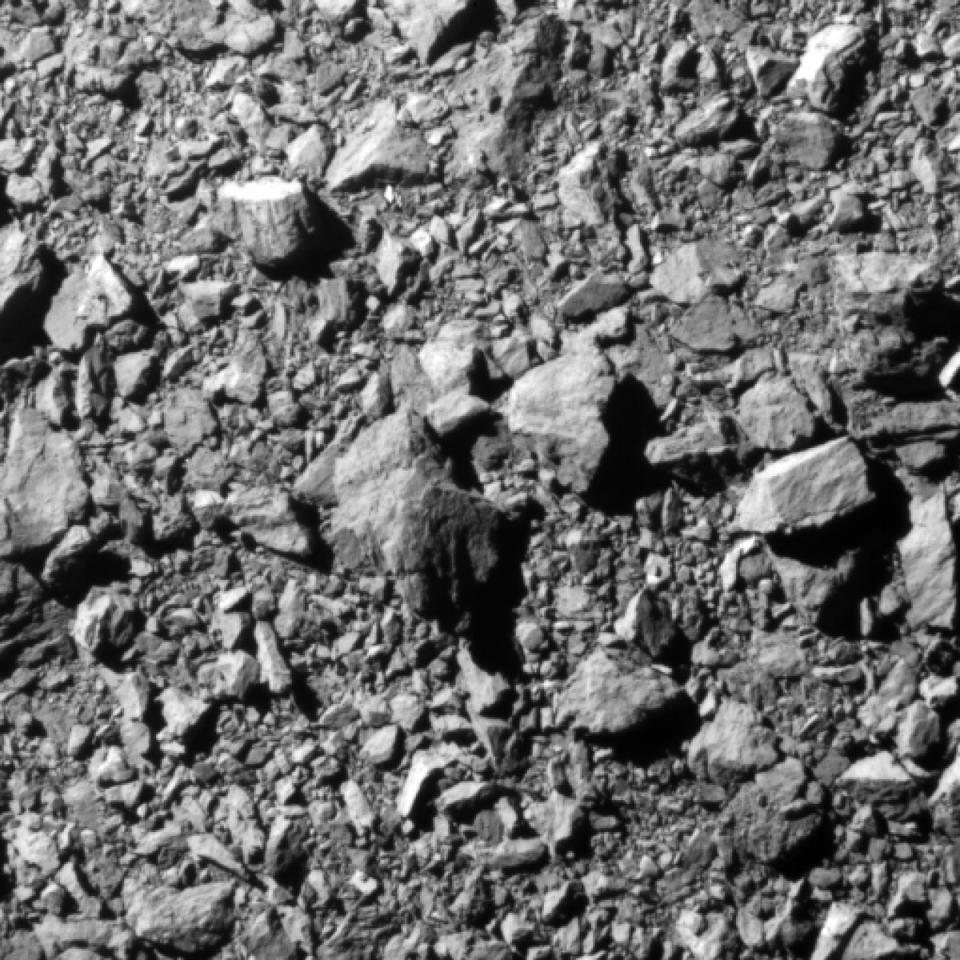Images of Nasa’s Dart spacecraft’s asteroid impact from around - and off - the world

On Monday, Nasa’s Double Asteroid Redirection Test, or Dart, made history as the first spacecraft to impact an asteroid and change its orbit.
The spacecraft also provided a live feed of astonishing images of the boulder strewn, egg-shaped asteroid Dimophos as Dart sped toward its final destination on that space rock’s bumpy gray surface, the first time any human had gazed upon that landscape.
But Dart’s cameras were not the only eyes watching Dimorphos on Monday. Ground-based telescopes from around the world as well as space-based telescopes on a nearby spacecraft and even the James Webb and Hubble space telescopes were all focused on Dimorphos Monday night, and while they couldn’t resolve the asteroid to the level of detail as the Dart spacecraft, they did get views of Dart’s demise.
Many of those images will take days or weeks to download and process, but some of the observers began posting videos and images of Dart’s impact almost immediately.
Among the first groups to share images of the impact was the Asteroid Terrestrial-impact Last Alert System, or Atlas Project, a network of four telescopes based in Hawaii, Chile, and South Africa. Atlas telescopes normally search for asteroids much smaller than the 530-foot diameter Dimorphos, and they had no trouble finding Dimorphos in the sky and catching the moment it brightened and cast off ejecta as Dart struck the space rock at 4 miles per second.
The Atlas project posted their short video of the collision to Twitter Monday evening.
ATLAS observations of the DART spacecraft impact at Didymos! pic.twitter.com/26IKwB9VSo
— ATLAS Project (@fallingstarIfA) September 27, 2022
The Atlas project has since posted another view of the impact, this time with the background stars motionless in the view, giving a better impression of the motion of Dimorphos.
Same video as before of ATLAS observing the DART impact, but tracked sidereally (with the stars). Each frame is about 40 seconds, and the entire sequence is about two hours. pic.twitter.com/p7Sgvfu2CK
— ATLAS Project (@fallingstarIfA) September 27, 2022
Les Makes Observatory on Reunion Island near Madagascar in the Indian Ocean, also caught the Dart impact in “real time,” or at least as close as possible to real time, given the 38 seconds it took light from the impact to reach Earth from 6.8 million miles away.
“The sequence of images they provided in real time was impressive: the asteroid immediately started brightening upon impact, and within a few seconds it was already noticeably brighter,” the European Space Agency’s Near Earth Objects Coordination Centre wrote of the Les Makes observations in a blog post. “Within less than a minute a cloud of ejected material became visible, and we could follow it while it drifted Eastward and slowly dissipated.”
The Virtual Telescope Project, a global network of robotic telescopes used by professional and amatuer astronomers alike, partnered with the Klein Karoo Observatory in Calitzdorp, South Africa, to capture yet another real time view of the Dart impact.
We made history last night, capturing the effects of Nasa’s #DARTMIssion on Dimorphos. We made possible to the people to see in real-time the target body increasing in brightness and developing a large cloud of debris.
🛰️👇🔭
Full report with images here:https://t.co/otUnEaNJyo pic.twitter.com/EX5j6fQwrP— Virtual Telescope (@VirtualTelescop) September 27, 2022
“Images were of good quality, something hard to believe, considering it was even raining a couple of hours earlier,” Italian astronomer and founder of the Virtual Telescope Project Gianluca Masi wrote of the observation. “But that delay was rewarded: we immediately noticed on the monitor a significant increase in brightness of asteroid (65803) Didymos! Pure joy.
In terms of space-based observations, the James Webb Space Telescope was watching Dimorphos at 7.14pm EDT when Dart struck the asteroid, and the Las Cumbres Observatory in Brazil has processed and shared the first Webb images of the impact through the observatory’s Céu Profundo, or Deep Sky project.
A imagem que vocês estavam esperando chegou! Já acessamos os dados do @NASAWebb e montamos um timelapse do asteroide Dimorphos após a colisão com a missão de teste de defesa planetária #DART. #AstroMiniBR pic.twitter.com/DWQEnyW7x9
— Projeto Céu Profundo (@CeuProfundo) September 27, 2022
“The image you've been waiting for has arrived! We have already accessed the data from the @NASAWebb and put together a timelapse of the asteroid Dimorphos after the collision with the #DART planetary defense test mission,” the post to Twitter reads in Portuguese.
The closest view of the Dart mission impact came from the Italian space agency’s Light Italian CubeSat for Imaging of Asteroids, or LiciaCube. LiciaCube is a microwave-sized spacecraft that hitched a ride on Dart for most of its journey to Dimorphos, separating just a couple of weeks prior to impact so it could observe the impact from a safe distance, flying about three minutes behind Dart.
Here are the first images taken by #LICIACube of #DARTmission impact on asteroid #Dimorphos.
Now weeks and months of hard work are now starting for scientists and technicians involved in this mission, so stay tuned because we will have a lot to tell! pic.twitter.com/kVz1WmcsL7— LICIACube (@LICIACube) September 27, 2022
In one of the images, a bright, spider-like splotch can be seen above a larger bright lump. The larger object is Didymos, the larger asteroid companion of Dimorphos, while the spider-like splotch is Dimorphos, surrounded by material ejected by Dart , all aglow from the intense energy released by the hypervelocity impact.
Of course, the best view in the house was Dart’s and Dart’s alone. In its final images, Dart’s cameras provide incredibly detailed views of the rocky surface of Dimorphos.

That last image is about 31 meters across, according to estimates by the Johns Hopkins Applied Physics Laboratory, which managed the Dart mission for Nasa, and Chris Lewicki, co-founder of the now defunct asteroid mining company Planetary Resources shared an image on Twitter Tuesday showing the golf-cart sized Dart spacecraft to scale over the image.
I wanted to get a sense of scale of what it was like just before #DARTMission impact. @JHUAPL estimated the image to be ~31m across, and the DART spacecraft is ~18m across, so this is a rough approximation.
Those boulders are big! pic.twitter.com/tNmqMhXFcP— Chris Lewicki (@interplanetary) September 27, 2022
More images from space and ground-based telescopes of the Dart impact will likely come out over the coming days and weeks, as scientists attempt to measure how much Dart changed the orbit of Dimorphos — the ultimate point of the mission was to test the possibility of using a Dart-like spacecraft to divert asteroids that might pose a hazard to Earth.
The final close up images that will reveal Dart’s fate and the impact crater it left in Dimorphos will have to wait until 2026. That’s when the European Space Agency’s Hera mission will arrive on the scene to make a final assignment of Dart’s impact.

